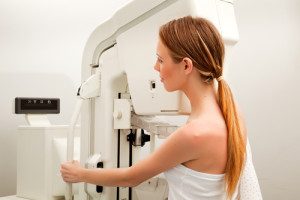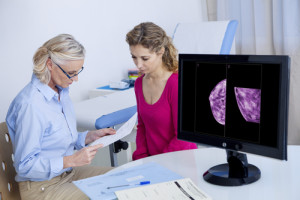THE SECRET HISTORY OF MAMMOGRAPHY
by Devra Davis, PhD
President and Founder, Environmental Health Trust, lecturer, San Francisco, London
Huffpost Healthy Living, Posted: 11/24/09 10:30 AM ET
 Mammography is one of the most oversold and understudied technologies in medical history. To continue to assert that mammography will save lives flies in the face of huge numbers of studies on the topic. Individual doctors treat individual women but do not and cannot study the patterns of disease in populations. That is the job of epidemiologists and other public health experts. Their work on the hard numbers confirms the sorry truth–mammography regularly used in women under age 50 produces more harm and does not reduce deaths.
Mammography is one of the most oversold and understudied technologies in medical history. To continue to assert that mammography will save lives flies in the face of huge numbers of studies on the topic. Individual doctors treat individual women but do not and cannot study the patterns of disease in populations. That is the job of epidemiologists and other public health experts. Their work on the hard numbers confirms the sorry truth–mammography regularly used in women under age 50 produces more harm and does not reduce deaths.
Most women, including Debbie Wasserman Schulz find their own tumors that are missed by mammograms.
By the 1970s, cancer specialists had long appreciated that breast cancer, like most adult forms of the illness, appears only after years of growth. Before it can be seen on x-ray, what starts out as an invisibly damaged solitary cell of the damaged breast has to elude millions of efforts to kill or fix it. Cancer cells feed on and spew out sugar, one of the fastest fuels it can consume. Doubling times of cancer cells can vary between 100 to 400 days.1 X-rays depict the remnants of this growth—the distinctive tracks of tiny specks of calcium that splitting cells leave—years before the disease can be seen or felt.
As one of the pioneers of the original technology, who had lost a young wife to the disease, Philip Strax put together the first large effort to see whether or not mammography made sense in New York City. It is no accident that the first trial of this slightly uncomfortable technology emerged in a city also known as a center for feminist health theory and practice. Then and now the Upper West Side of Manhattan was a hotbed of women’s body politics.
Working with one of the largest managed health care systems, the Health Insurance Plan of New York (HIP), in 1963, the study found more than 60,000 women who agreed to take part. Half were randomly assigned to get a mammogram, in order to find out whether or not healthy women with no sign of cancer would benefit. The program was stunning in breadth, bold and brash.
By 1971 the results were clear. Women over fifty who had regular mammograms died less often from breast cancer. If they developed tumors, their growths tended to be smaller and less advanced than women who had not undergone screening. But regarding those under fifty, the story was not encouraging. They fared no better with mammograms than without. After this trial ended, some scientists urged more testing before younger women were subjected to mammography radiation. Rosalie Bertell, the visionary critic, and John Gofman, the renegade physician from the Nuclear Regulatory Commission, warned that radiation incurred from regular testing could itself carry a risk of producing precisely the cancer such screening was intended to stave off.2
Because younger breasts are more dense, on x-ray they are riddled with lots of white spots, making it really hard to make out any tumor within. It’s fortunate that most young breasts don’t get cancer, since mammography is a pretty poor way to find them.
The impact of showing that mammography actually worked on older women was breathtaking. The long drought of failed promises was over. Finally, after years of promises, a life-sparing technology was at hand.
Convinced that all women would benefit from regular mammograms and caught up in the political and economic enthusiasm of combating cancer, the National Cancer Institute (NCI) and the American Cancer Society (ACS) launched a massive demonstration project on breast cancer detection in 1972 that covered women of all ages. But this national program effectively killed prospects for ever finding out whether or not mammography works in younger women.
Project leaders like Arthur I. Holleb, a senior ACS official, ardently believed in what they were doing. This would not be the last time fervent beliefs got in the way of scientific research. The campaign for mammography became wrapped in military metaphors that resonated with a public already wearied of the failed conflict in Southeast Asia. Holleb urged putting this life-saving technology into broad operation as soon as possible.
“No longer can we ask the people of this country to tolerate a loss of life from breast cancer each year equal to the loss of life in the past ten years in Viet Nam. The time has come for greater national effort. I firmly believe that time is now.”3
Ironically, this full-court press for healthy women to have mammograms may well have been launched to make up for delays in providing regular screening for cervical cancer with the Pap smear. By 1971 it was clear that haggling over the Pap test for cervical abnormalities—long after it had been shown to work in the 1950s—meant that thousands of women developed cancers they could have avoided. Women had always been enthusiastic supporters of the ACS. As cervical cancer rates were dropping, breast cancer was growing in importance. Here was a chance to do something about it. If screening worked for cervical cancer, and did so for women at all ages, why should mammography be any different?
Economists were not widely engaged in such matters at the time. They ask questions such as, “Are the costs of using this procedure on women of certain ages in line with the benefits?” Costs are the simple part. Benefits are harder to measure. The actual number of lives saved can be estimated, but what about unnecessary radiation and surgery to look for things that appear to be cancer and turn out not to be? What about the terror that women go through as they wait for further testing and biopsies of suspicious growths, most of which turn out to be nothing? What are the chances of mistakes being made? These questions were not easily asked at the time. If they had been, the world might look rather different.
Strax understood that a revolution in public attitudes was needed for mammography screening to work. A book he published in 1974 sent a welcome message—Early Detection: Breast Cancer Is Curable. Finally the ACS and NCI had a champion who spoke the four-letter word that few had dared to utter: cure. Sometimes personal enthusiasms, even for scientists, are hard to hold in check. Haunted by what had happened to his young wife, Strax became an ardent advocate for mammography. He believed it had to work. He likened the failure to get a mammogram to walking into a busy street without looking both ways. A woman who ignored the risk of breast cancer faced disaster. “Or, she may be constantly on her guard, aware that she may be affected, but with the assurance that early detection may save her life. Which course should you follow?”4
Some four decades after the start of the American Society for Cancer Control, leaders in cancer research were ecstatic. They felt sure they finally had a technology that could deliver on the old promise that finding cancer early saves lives. The mammography demonstration project was massive and without precedent: more than a quarter million women between thirty-five and seventy-four would be provided mammograms every year. Medical advertisers had a field day as companies began to ramp up to produce all the machines that would be needed.
As Barron Lerner has pointed out in his critical history of this era, the promotion of regular x-ray exams of the breast played into two important American beliefs. Women are charged with a moral duty to take charge of their health, and technology offered them a way to beat the odds against one of the most common causes of death in middle-age women.
The push for mammography cannot be separated from the rise of feminism at about the same time. Women’s body parts and lives were named and bandied about at the time in ways that were nothing short of revolutionary. In some circles, women met in groups, equipped with mirror, flashlight and speculum, to learn how to gaze at their hidden cervix. Breast cancer also came out of the closet and bedroom. Diagrams showed women how to feel their own breasts and encouraged them to do so regularly to try to find early tumors. There has never been any evidence that regular self-exams keep women from dying of breast cancer.5 Still, many believe that getting women comfortable with touching their bodies may eventually turn out to be useful as a way to find the disease earlier. And, unlike many breast cancer tests and technologies, this one is free and has no downside.
A further boost to mammography came from reports that First Lady Betty Ford, Margaretta (Happy) Rockefeller, the wife of Vice President Nelson Rockefeller, and Marvella Bayh (wife of Sen. Birch Bayh) had been diagnosed and successfully treated for breast cancer. Reflecting this newfound public interest in breast cancer and the expanded access to screening, the officially recorded incidence of breast cancer rose nearly 15 percent between 1973 and 1974—from 82.6 to 94.9 per 100,000 women of all ages.
By 1990, enthusiasm for the technology had begun to fade. Gina Kolata, a science reporter known for her advocacy of mammograms, reported in the New York Times that not all mammograms were equal. “Proponents and opponents agree that a serious problem exists with mammography: A large proportion of test sites use substandard equipment, are staffed by inadequately trained technicians and radiologists, or are rarely if ever inspected to be sure the equipment is working properly at a minimal dose of radiation.”6
The federal government didn’t even have national standards for mammography until 1994. This only happened after John Dingell, William Ford, Marilyn Lloyd, Patricia Schroeder, Henry Waxman, and a number of champions of women’s health, including Assistant Surgeon General Susan Blumenthal, married to Congressman Ed Markey, and NIH director Bernadine Healy, demanded such a program be put in place.7 I had visited Arkansas that year, working for Jocelyn Elders, the surgeon general. We learned that in one out of every three clinics mammograms were given by persons who had no training, including office receptionists.
 When I told my husband not to worry about my own callback in 1993, I had solid numbers in mind. I knew that if one thousand women had regular mammograms starting when they were forty, each year seventy of them would be called back, as I was, for further testing or surgery. This could involve more radiation through magnified x-rays or a surgical biopsy to examine cells under the microscope for cancer. By the time these thousand women reached fifty, seven hundred of them would have been called back for repeated testing. Many of them would have gone through biopsies. Nearly all of them would have been just fine.
When I told my husband not to worry about my own callback in 1993, I had solid numbers in mind. I knew that if one thousand women had regular mammograms starting when they were forty, each year seventy of them would be called back, as I was, for further testing or surgery. This could involve more radiation through magnified x-rays or a surgical biopsy to examine cells under the microscope for cancer. By the time these thousand women reached fifty, seven hundred of them would have been called back for repeated testing. Many of them would have gone through biopsies. Nearly all of them would have been just fine.
Susan Love, the famed breast surgeon, and I had written a commentary on all this in the Journal of the American Medical Association. We explained that the breasts of women who are still menstruating regularly contain things that can be hard to interpret. The younger the breast, the more dense it looks on x-ray. But x-rays go right through older, fatty breasts. Fat is radiolucent, showing up as dark black on x-ray images. Against the sharp black background, tiny deposits of calcium smaller than the head of a pin—the microscopic residues of calcium traces from tumor growth—tell us whether or not cancer lurks within the breast.
But dense breasts, like the ones I had at the time, tend to look full of snow, created by the abundance of epithelial and connective tissue that also leaves white tracks. They pose the classic problem that hunters know very well: you can’t spot an elk behind a single tree within the forest where it’s hiding. I tried to tell my husband all this. He wouldn’t listen.
Like many people, he believed that any sign of growth in the breast had to come out. I knew that this simple way of thinking came about because the fear of breast cancer can be terrorizing, perhaps especially so for spouses. But I also knew that most breast tumors in women just before menopause turn out to be benign. I was willing to bet on it.
So far, I’ve been right.
I knew my numbers regarding regular mammography in women under fifty because of my work on the JAMA article. Karla Kerlikowski at the University of California–San Francisco had found that women under age fifty account for only one in five cases of breast cancer. Yet those of this age who had gone through yearly tests had more than twice as many surgeries, and nearly three times more follow-up diagnostic procedures as those over fifty. We worried about the fact that women whose lives could be saved by mammography—those over fifty—were getting fewer exams, while those in whom it made less sense were getting more of them.
We concluded our report with these words, which are repeated here, because they remain pertinent, more than a decade later:The public policy dilemma posed by these findings for women and their health providers in the United States today is profound. Chalmers has reminded us that “if our society had been oriented towards finding out whether new technology is efficacious as soon as possible after its introduction there would not be much left to debate more than 30 years (later).” . . . But wistful wishing cannot alter the fact that mammographic screening in women under 50 years of age does not reduce deaths, while for those over the age of 50 years it saves lives. The reasons for these results are unknown and need to be resolved through additional clinical studies that assess the importance of menopausal status and other factors, including breast tissue change with age. In the meantime, women must be told the truth, so they can make informed choices about their health care. And efforts must proceed apace to develop better techniques to detect early breast cancer in asymptomatic younger women, to ensure that all women over 50 years of age are provided access to the lifesaving benefit of screening mammography, and to identify avoidable causes of this major cancer.8
The fact is, even at their best, mammograms do not prevent breast cancer. They do not work well in young women. We need to invest in research to identify avoidable causes of this disease, such as those identified in The State of the Evidence–a review of environmental and occupational causes of breast cancer prepared by www.breastcancerfund.org We also need to invest in new investigations to develop blood or urine tests of molecular changes that will predict breast cancer risk. Playing politics with mammograms may increase television ratings but poorly serves the public interest. www.environmentalhealthtrust.org






